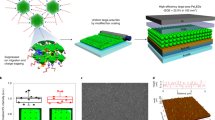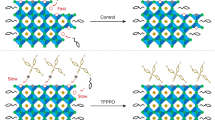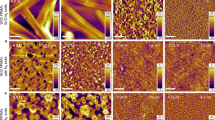Abstract
Halide perovskites are enticing candidates for highly efficient planar light-emitting diodes (LEDs) with commercial potential in displays and lighting. However, it remains a challenge for conventional solution fabrication processes to fabricate large-scale or non-planar LEDs due to the non-uniformity of perovskite films in conjunction with material stability issues. Here large-area highly uniform arrays of crystalline perovskite quantum wires are grown with emission spectra covering the whole visible range. Photoluminescence quantum yield of up to 92% and 5,644 hours as the time for photoluminescence to degrade down to its 50% of the initial value under ambient conditions are achieved for MAPbBr3 quantum wires. LEDs based on these quantum wires on rigid and flexible planar substrates are fabricated up to a four-inch wafer size and also unique three-dimensional spherical LEDs with outstanding uniformity are reported. The results suggest that the approach developed here can be generalized to other unconventional three-dimensional LEDs in the future.
This is a preview of subscription content, access via your institution
Access options
Access Nature and 54 other Nature Portfolio journals
Get Nature+, our best-value online-access subscription
$29.99 / 30 days
cancel any time
Subscribe to this journal
Receive 12 print issues and online access
$209.00 per year
only $17.42 per issue
Buy this article
- Purchase on Springer Link
- Instant access to full article PDF
Prices may be subject to local taxes which are calculated during checkout






Similar content being viewed by others
Data availability
The data that support the findings of this study are available from the corresponding author upon reasonable request.
References
Stranks, S. D. & Snaith, H. J. Metal-halide perovskites for photovoltaic and light-emitting devices. Nat. Nanotechnol. 10, 391–402 (2015).
Xiao, Z. G. et al. Efficient perovskite light-emitting diodes featuring nanometre-sized crystallites. Nat. Photon. 11, 108–115 (2017).
Cho, H. et al. Overcoming the electroluminescence efficiency limitations of perovskite light-emitting diodes. Science 350, 1222–1225 (2015).
Liu, F. et al. Highly luminescent phase-stable CsPbI3 perovskite quantum dots achieving near 100% absolute photoluminescence quantum yield. ACS Nano 11, 10373–10383 (2017).
Deng, W. et al. Organic–inorganic hybrid perovskite quantum dots for light-emitting diodes. J. Mater. Chem. C 6, 4831–4841 (2018).
Liu, Y. et al. Efficient blue light-emitting diodes based on quantum-confined bromide perovskite nanostructures. Nat. Photon. 13, 760–764 (2019).
Lin, K. et al. Perovskite light-emitting diodes with external quantum efficiency exceeding 20 per cent. Nature 562, 245–248 (2018).
Richter, J. M. et al. Enhancing photoluminescence yields in lead halide perovskites by photon recycling and light out-coupling. Nat. Commun. 7, 13941 (2016).
Berhe, T. A. et al. Organometal halide perovskite solar cells: degradation and stability. Energy Environ. Sci. 9, 323–356 (2016).
Zhang, D. et al. Ultrathin colloidal cesium lead halide perovskite nanowires. J. Am. Chem. Soc. 138, 13155–13158 (2016).
Teunis, M. B. et al. Mesoscale growth and assembly of bright luminescent organolead halide perovskite quantum wires. Chem. Mater. 28, 5043–5054 (2016).
Tan, C. K. & Tansu, N. Nanostructured lasers: electrons and holes get closer. Nat. Nanotechnol. 10, 107–109 (2015).
Zhang, D. et al. Increasing photoluminescence quantum yield by nanophotonic design of quantum-confined halide perovskite nanowire arrays. Nano Lett. 19, 2850–2857 (2019).
Yuen, P. Y., Moffitt, S. L., Novoa, F. D., Schelhas, L. T. & Dauskardt, R. H. Tearing and reliability of photovoltaic module backsheets. Prog. Photovolt. Res. Appl. 27, 693–705 (2019).
Rolston, N. et al. Effect of cation composition on the mechanical stability of perovskite solar cells. Adv. Energy Mater. 8, 1702116 (2018).
Gu, L. et al. 3D arrays of 1024-pixel image sensors based on lead halide perovskite nanowires. Adv. Mater. 28, 9713–9721 (2016).
Waleed, A. et al. Lead-free perovskite nanowire array photodetectors with drastically improved stability in nanoengineering templates. Nano Lett. 17, 523–530 (2017).
Waleed, A. et al. All inorganic cesium lead iodide perovskite nanowires with stabilized cubic phase at room temperature and nanowire array-based photodetectors. Nano Lett. 17, 4951–4957 (2017).
Gu, L. et al. Significantly improved black phase stability of FAPbI3 nanowires via spatially confined vapor phase growth in nanoporous templates. Nanoscale 10, 15164–15172 (2018).
Soeda, J. et al. High electron mobility in air for N,N'-1H,1H-perfluorobutyldicyanoperylene carboxydi-imide solution-crystallized thin-film transistors on hydrophobic surfaces. Adv. Mater. 23, 3681 (2011).
Diggle, J. W., Downie, T. C. & Goulding, C. Anodic oxide films on aluminum. Chem. Rev. 69, 365–405 (1969).
Simmons, J. G. Generalized formula for the electric tunnel effect between similar electrodes separated by a thin insulating film. J. Appl. Phys. 34, 1793–1803 (1963).
Li, J. et al. Perovskite light-emitting devices with a metal–insulator–semiconductor structure and carrier tunnelling. J. Mater. Chem. C 5, 7715–7719 (2017).
Kam, M. et al. Efficient mixed-cation mixed-halide perovskite solar cells by all-vacuum sequential deposition using metal oxide electron transport layer. Sol. RRL 3, 1900050 (2019).
Eames, C. et al. Ionic transport in hybrid lead iodide perovskite solar cells. Nat. Commun. 6, 7497 (2015).
Lee, H., Ko, D. & Lee, C. Direct evidence of ion-migration-induced degradation of ultrabright perovskite light-emitting diodes. ACS Appl. Mater. Interfaces 11, 11667–11673 (2019).
Tan, Z. F. et al. Spectrally stable ultra-pure blue perovskite light-emitting diodes boosted by square-wave alternating voltage. Adv. Optical Mater. 8, 1901094 (2020).
Liu, J. J. et al. All-inorganic perovskite quantum dots/p-Si heterojunction light-emitting diodes under d.c. and a.c. driving modes. Adv. Optical Mater. 6, 1700897 (2018).
Park, S. et al. Efficient large-area transparent OLEDs based on a laminated top electrode with an embedded auxiliary mesh. ACS Photonics 4, 1114–1122 (2017).
Cheng, T., Wu, Y., Shen, X., Lai, W. & Huang, W. Inkjet printed large-area flexible circuits: a simple methodology for optimizing the printing quality. J. Semicond. 39, 015001 (2018).
Kanninen, M. An augmented double cantilever beam model for studying crack propagation and arrest. Int. J. Fract. 9, 83–92 (1973).
Amani, M. et al. Near-unity photoluminescence quantum yield in MoS2. Science 350, 1065–1068 (2015).
Zhang, Q. et al. Efficient metal halide perovskite light-emitting diodes with significantly improved light extraction on nanophotonic substrates. Nat. Commun. 10, 727 (2019).
Acknowledgements
This work was financially supported by the National Natural Science Foundation of China (project no. 51672231), Shenzhen Science and Technology Innovation Commission (project no. JCYJ20170818114107730), Hong Kong Research Grant Council (General Research Fund Project nos. 16214619, 16205321 and 16309018), HKUST Fund of Nanhai (grant no. FSNH-18FYTRI01), Guangdong-Hong Kong-Macao Intelligent Micro-Nano Optoelectronic Technology Joint Laboratory (grant no. 2020B1212030010), Independent Research Fund Denmark—Sapere Aude Starting Grant (no. 7026-00037A) and Swedish Research Council VR Starting Grant (no. 2017-05337). Y.L. acknowledges financial support by grant RGC CityU11207416. We thank D.-H. Lien and A. Javey (Electrical Engineering and Computer Sciences, University of California, Berkeley) for their technical assistance on the PLQY measurement and analysis. We also thank X. Ma (Core Research Facilities, Southern University of Science and Technology, China) and B. Han (Department of Materials Science and Engineering, Southern University of Science and Technology, China) for their technical assistance on the sputtering process and TEM measurements, respectively. We also acknowledge support from the Material Characterization and Preparation Facility (MCPF), the Nanosystem Fabrication Facility (NFF), the Center for 1D/2D Quantum Materials and the State Key Laboratory of Advanced Displays and Optoelectronics Technologies at HKUST.
Author information
Authors and Affiliations
Contributions
Z.F. conceived the ideas and supervised the work. D.Z. grew the QW samples and carried out the optical spectroscopy, XRD, SEM and TEM characterizations. D.Z. and Q.Z. fabricated and characterized the LED devices with help from B.R., Y.Zhu, Y.F., B.C., L.G., Y.D., S.P., L.S. and Y.Zhang. C.W. helped with the ALD process. Y.D. helped with drawing the schematic. K.T. helped with Al sputtering and hydrophobic treatment. M.A. carried out the PLQY measurement. D.-B.K. and J.-F.L. carried out the TA measurements. S.F. and Y.L. carried out the thin-film cohesion test. D.Z., Q.Z., K.Z., Z.H. and Z.F. carried out the data analysis and wrote the manuscript. All the authors discussed the results and commented on the manuscript.
Corresponding author
Ethics declarations
Competing interests
The authors declare no competing interests.
Peer review
Peer review information
Nature Photonics thanks Qihua Xiong and the other, anonymous, reviewer(s) for their contribution to the peer review of this work.
Additional information
Publisher’s note Springer Nature remains neutral with regard to jurisdictional claims in published maps and institutional affiliations.
Supplementary information
Supplementary Information
Supplementary Figs. 1–25, Discussion and Tables 1 and 2.
Supplementary Video 1
Water stability demonstration of MAPbBr3 QWs in PAM with a hydrophobic surface.
Supplementary Video 2
Real-time measurement of a perovskite LED device with voltage scanning from 0 to 8 V.
Supplementary Video 3
Two-axis rotation for electrode deposition on the 3D spherical device.
Rights and permissions
About this article
Cite this article
Zhang, D., Zhang, Q., Ren, B. et al. Large-scale planar and spherical light-emitting diodes based on arrays of perovskite quantum wires. Nat. Photon. 16, 284–290 (2022). https://doi.org/10.1038/s41566-022-00978-0
Received:
Revised:
Accepted:
Published:
Issue Date:
DOI: https://doi.org/10.1038/s41566-022-00978-0
This article is cited by
-
Vapour-deposited perovskite light-emitting diodes
Nature Reviews Materials (2024)
-
Large-area waterproof and durable perovskite luminescent textiles
Nature Communications (2023)
-
High-efficiency, flexible and large-area red/green/blue all-inorganic metal halide perovskite quantum wires-based light-emitting diodes
Nature Communications (2023)
-
On-site growth of perovskite nanocrystal arrays for integrated nanodevices
Nature Communications (2023)
-
Towards micro-PeLED displays
Nature Reviews Materials (2023)



